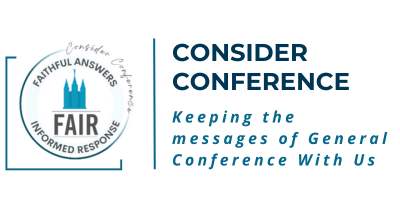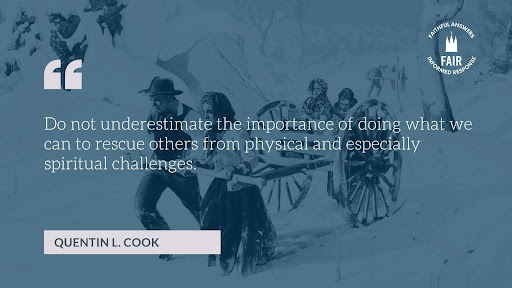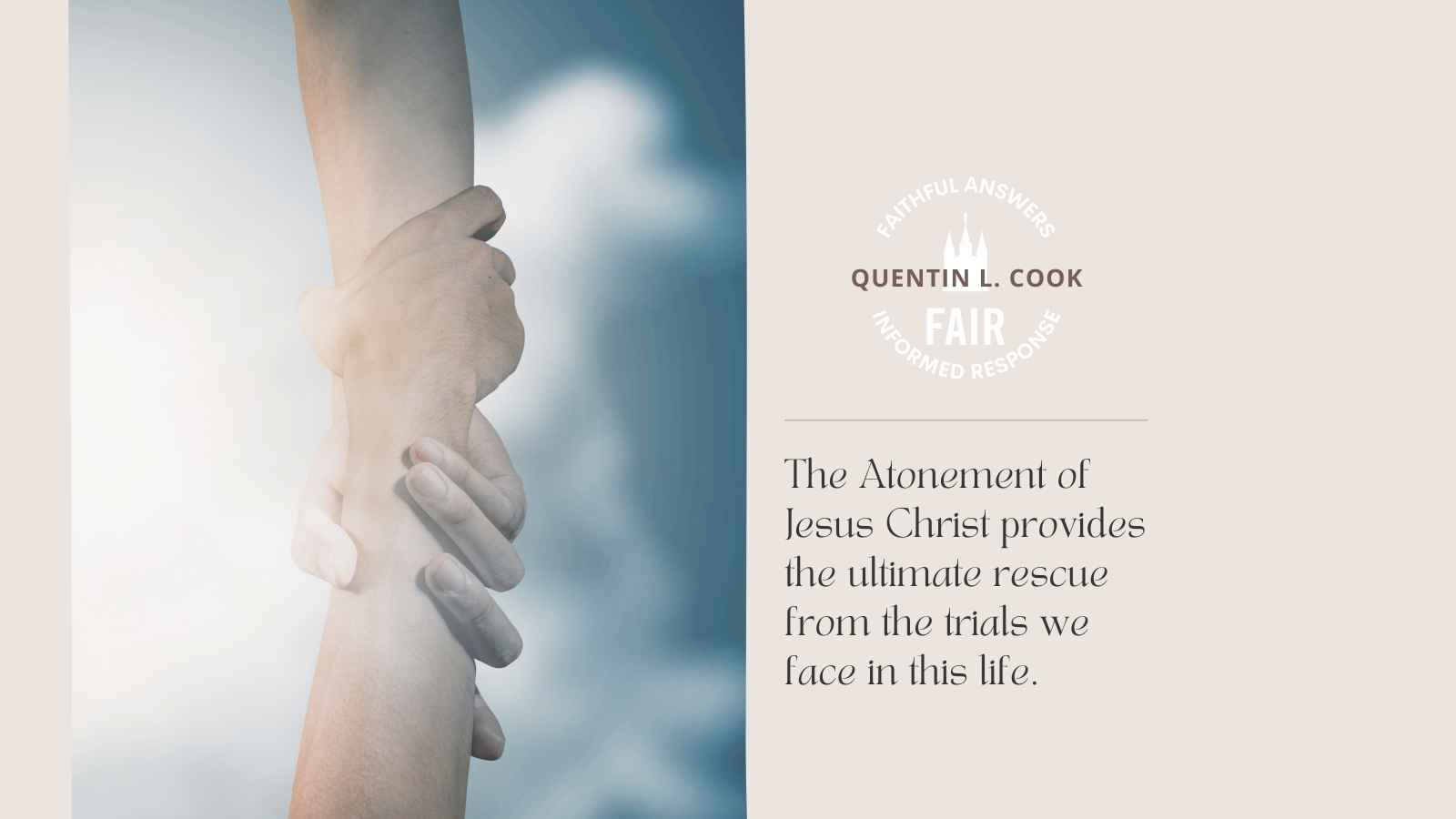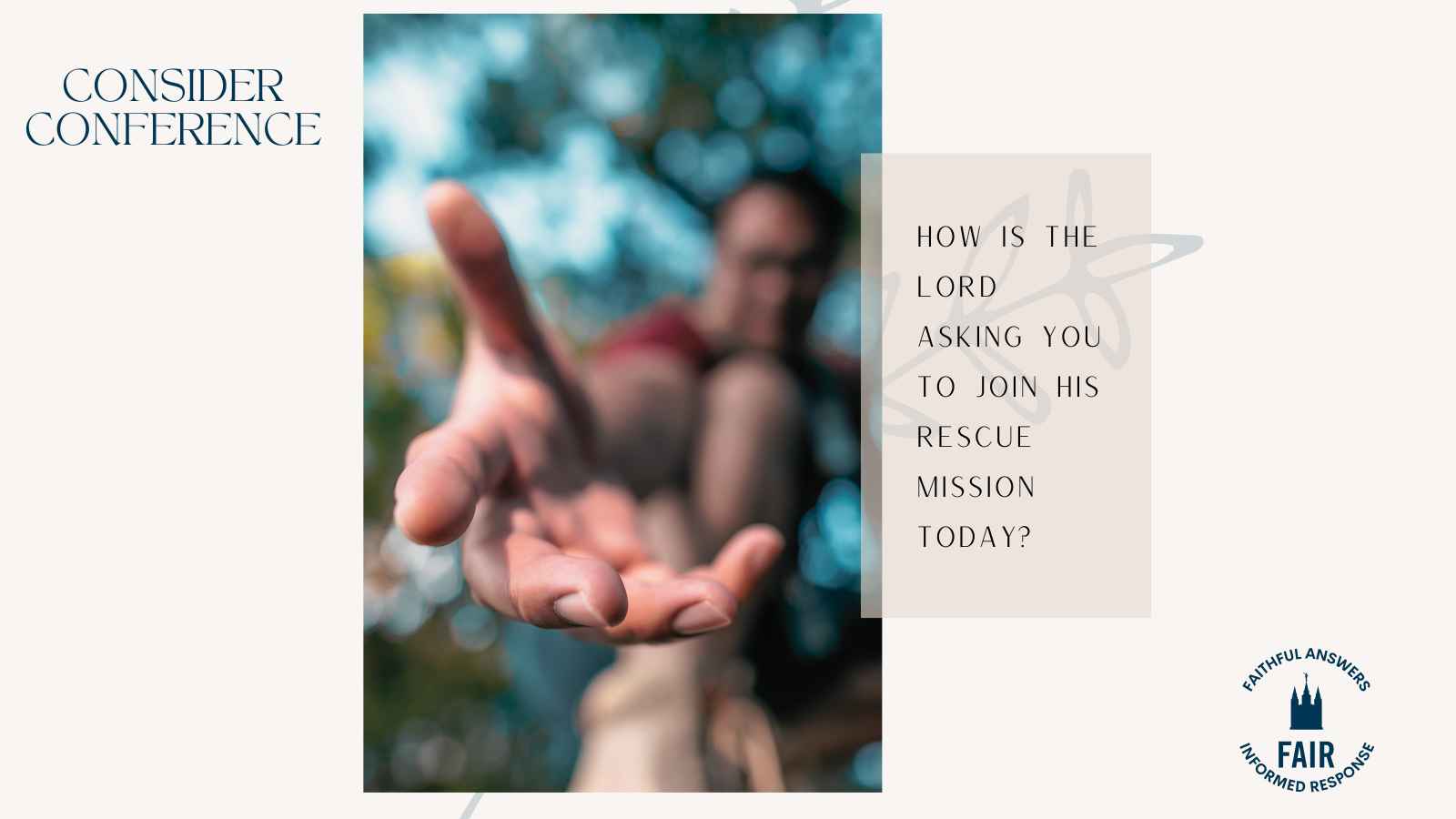
Finding Safety and Strength Through Christ’s Atonement, Prophetic Order, and Consecrated Service
Have you ever felt caught in a storm—not just in the weather, but in life itself? Trials, grief, injustice, confusion, or even the weight of others’ harmful choices can leave us stranded, unsure where to turn.
In his powerful General Conference address, The Atonement of Jesus Christ Provides the Ultimate Rescue, Elder Quentin L. Cook of the Quorum of the Twelve Apostles testifies that Jesus Christ stands ready to rescue each of us through His infinite Atonement. But Elder Cook’s message doesn’t stop there. Drawing on the moving history of the Willie and Martin handcart companies, he reminds us that prophetic leadership and covenant discipleship are vital parts of the Lord’s rescue plan.
As we study Doctrine and Covenants 41–44 this week, we see these same principles in action:
- The order of revelation through a living prophet protects and unifies the Saints (D&C 43:1–7).
- The law of consecration invites us to participate in Christ’s rescuing work—not through compulsion, but through love and covenant commitment (D&C 42:30–42).
In a world that often questions the need for prophetic authority or dismisses commandments as restrictive, Elder Cook’s testimony offers a bold counterpoint: these divine patterns are not control—they are the very means by which Christ’s rescue reaches us.
So how can we better understand the Atonement’s power, recognize the blessing of order in revelation, and willingly join Christ’s mission to lift and rescue others?
Let’s explore.

 Apologetic Issues: The Atonement, Prophetic Leadership, and Covenant Rescue
Apologetic Issues: The Atonement, Prophetic Leadership, and Covenant Rescue
Question: “Why does the Church claim that only the President of the Church can receive revelation for the whole Church? Shouldn’t everyone be free to receive revelation for the group, just as they do for their own lives?”
Response: The doctrine of prophetic authority protects against confusion and division within Christ’s Church. The Lord revealed in Doctrine and Covenants 43:1–7 that only the designated prophet receives revelation for the entire body of Saints, ensuring unity, order, and clarity. Elder Quentin L. Cook’s recounting of the Willie and Martin handcart rescue illustrates this principle in action: it was Brigham Young’s prophetic leadership and timely call to action that saved hundreds of lives.
This divine pattern mirrors biblical precedent (e.g., Moses leading Israel, Peter guiding the early Christian church). It is not about silencing personal revelation but about recognizing different stewardship roles: personal revelation for individual lives and families, prophetic revelation for the Church at large.
Common Fallacy: Appeal to Emotion (Emotional Reasoning)
This argument often appeals to feelings of fairness or personal offense (“Why can’t I receive revelation for the Church too?”), but emotional discomfort is not evidence against true principles. Feelings alone cannot substitute for the divine order established by Christ. Correct reasoning recognizes that unity requires clear channels of authority, which in this case are established by revelation, not human preference.
Solution:  Prophetic leadership is not about limiting revelation—it is about providing order to revelation. It ensures that the Church can act decisively and in unity, especially when lives (physical or spiritual) are at stake.
Question: “Doesn’t the law of consecration mean the Church controls people’s money and resources? Isn’t this just religious socialism?”
Response: The law of consecration is not about control—it is about voluntary covenant partnership in the Lord’s work. As taught in Doctrine and Covenants 42:30–42, consecration allows members to willingly dedicate their resources to help care for the poor and advance the Lord’s purposes.
Elder Cook’s talk highlights how the rescue of the handcart companies required the Saints to give freely of their resources—mule teams, wagons, flour, time, and labor. This was not imposed by force but invited by prophetic call and met with love and generosity. Likewise, consecration today is about choosing to be part of the Savior’s mission to rescue, lift, and bless others.
Common Fallacy: Straw Man
This criticism misrepresents the law of consecration as coercive socialism (the Straw Man Fallacy) by ignoring its voluntary, covenantal nature. The truth is that consecration respects agency and emphasizes willing sacrifice out of love, not forced redistribution. Correct understanding restores the principle’s beauty and sacred intent.
Solution: Rather than exploitation, consecration reflects Christlike love and stewardship. It offers an antidote to selfishness and inequality, creating opportunities for collective care and shared spiritual growth.

 Apologetic Application: The Atonement of Jesus Christ and the Law of Consecration—Rescue Rooted in Covenant Love
Apologetic Application: The Atonement of Jesus Christ and the Law of Consecration—Rescue Rooted in Covenant Love
Elder Quentin L. Cook’s talk powerfully teaches that the Atonement of Jesus Christ is the ultimate rescue—but the Lord’s rescue plan also calls on us to participate through covenant living.
 Core Doctrine: The Atonement of Jesus Christ empowers both personal salvation and covenant community rescue. Through the Atonement, Christ rescues us not only from sin and death (see Mosiah 15:8–9; Alma 34:16) but also invites us into His work of healing and lifting others (see Doctrine and Covenants 42:30–42). The law of consecration is a covenantal expression of this doctrine—it aligns our hearts with the Savior’s mission to “remember the poor” and to be His hands in the rescue.
Core Doctrine: The Atonement of Jesus Christ empowers both personal salvation and covenant community rescue. Through the Atonement, Christ rescues us not only from sin and death (see Mosiah 15:8–9; Alma 34:16) but also invites us into His work of healing and lifting others (see Doctrine and Covenants 42:30–42). The law of consecration is a covenantal expression of this doctrine—it aligns our hearts with the Savior’s mission to “remember the poor” and to be His hands in the rescue.
Defending Core Beliefs:
1⃣ Misconception: The Church uses commandments like consecration to control its members.
 Clarification:  The law of consecration is not coercion—it is an invitation to Christlike partnership. As Elder Cook describes the handcart rescue, no one was forced to give wagons, food, or labor. The Saints responded to prophetic counsel willingly because they understood that participating in rescue is part of discipleship. Likewise, the Atonement calls each of us to act, not merely to receive.
Clarification:  The law of consecration is not coercion—it is an invitation to Christlike partnership. As Elder Cook describes the handcart rescue, no one was forced to give wagons, food, or labor. The Saints responded to prophetic counsel willingly because they understood that participating in rescue is part of discipleship. Likewise, the Atonement calls each of us to act, not merely to receive.
2⃣ Misconception: Revelation doesn’t need to be centralized in one leader.
 Clarification:
Clarification:
Without order, the rescue would fail. The Willie and Martin rescue succeeded because the Saints responded to the prophetic call of Brigham Young, following the divinely appointed process revealed in Doctrine and Covenants 43:1–7. This pattern mirrors the Atonement itself—Christ is the one authorized Mediator between God and man (see 1 Timothy 2:5). Likewise, prophetic leadership ensures unity and direction in the collective work of salvation.
Application for Clarifying Misunderstandings:
This doctrine helps correct the narrative that commandments and prophetic guidance are about control. Instead, they are how Christ organizes His rescue mission—they empower us to act in harmony, with purpose, and in love. Rather than limiting agency, covenant commitments like consecration amplify our ability to serve meaningfully, making us partners in Christ’s redemptive work.
 Practical Apologetic Use:
Practical Apologetic Use:
When questions arise about prophetic authority or commandments being “too controlling,” this doctrine offers a simple, powerful reply:
The Lord’s rescue is both personal and collective. Commandments like consecration and the pattern of prophetic leadership are not control—they are how Christ extends His Atonement into the lives of others through us.
 Historical and Doctrinal Connections
Historical and Doctrinal Connections
Throughout scripture and the history of the Restoration, the Lord’s rescue of His people has followed a consistent pattern: divine authority, covenant commitment, and collective action under prophetic leadership. Elder Quentin L. Cook’s message in “The Atonement of Jesus Christ Provides the Ultimate Rescue” echoes these sacred patterns, reminding us that the Savior’s Atonement empowers both personal deliverance and community rescue—and that such rescue is always organized by divine law.
 Contextual Background:
Contextual Background:
In 1856, the Willie and Martin handcart companies found themselves stranded on the plains, facing starvation and death. Their survival depended on timely rescue, inspired by prophetic direction. Brigham Young’s leadership, calling on the Saints to consecrate their resources and act immediately, reflected the same divine order the Lord established in ancient Israel under Moses, and later in Christ’s early Church under Peter.
Elder Cook emphasizes that the pattern of prophetic leadership and willing discipleship is not a relic of the past—it is the way the Lord continues to govern and care for His people today.
 Doctrinal Connections:
Doctrinal Connections:
This week’s Come, Follow Me lesson in Doctrine and Covenants 41–44 reinforces the same principles Elder Cook highlights:
- The Lord declares that “he that receiveth my law and doeth it, the same is my disciple” (D&C 41:5).
- Revelation for the Church is to come through one appointed—to prevent confusion and maintain unity (D&C 43:1–7).
- The law of consecration, taught in D&C 42:30–42, calls each Saint to willingly dedicate time, talents, and means to lift the poor and carry forward the Lord’s work.
These doctrines affirm that the Atonement is not only about being rescued—it is about being called to participate in the rescue.
By aligning ourselves with prophetic counsel and covenant living, we become instruments in Christ’s hands, part of His loving and ordered plan to redeem, heal, and save.
 Living Apologetics: Becoming Part of the Rescue
Living Apologetics: Becoming Part of the Rescue
  Principle: How can we help others understand that commandments, consecration, and prophetic leadership are not about control—but about participating in Christ’s rescue mission?
 Principle: How can we help others understand that commandments, consecration, and prophetic leadership are not about control—but about participating in Christ’s rescue mission?
 Key Principle:
Key Principle:
Elder Quentin L. Cook teaches that the Atonement of Jesus Christ provides the ultimate rescue—and we are invited to assist in that rescue through willing sacrifice, covenant commitment, and heeding prophetic guidance.
 Practical Application
Practical Application
1⃣ Reframe Criticism as a Question of Purpose, Not Power:
When someone asks, “Why does the prophet have to make the decisions?” respond with:
“In any rescue operation, success depends on clear leadership and willing hearts. Prophetic leadership is how the Lord ensures that the rescue happens—on time and in order.”
Draw on Elder Cook’s example of the Willie and Martin handcart rescue where Brigham Young’s call was essential.
2⃣ Clarify the Covenant Nature of Consecration:
When faced with, “Isn’t consecration just a religious form of socialism?” explain:
“Consecration is about love, not control. It’s not about being forced—it’s about choosing to join Christ in blessing and rescuing others.”
Use the handcart rescuers as a real-life analogy of consecration in action.
Faith in Action: Share the Message
 1. Family Conversation:  Talk with your family about what it means to “join the rescue.” Discuss how commandments like consecration and prophetic guidance are invitations to partner with Christ—not restrictions.
1. Family Conversation:  Talk with your family about what it means to “join the rescue.” Discuss how commandments like consecration and prophetic guidance are invitations to partner with Christ—not restrictions.
 2. Teaching Moment:  When teaching Come, Follow Me or giving a talk, use the handcart rescue as a parallel to D&C 42–44. Emphasize the importance of order, revelation, and covenant service in both personal and collective salvation.
2. Teaching Moment:  When teaching Come, Follow Me or giving a talk, use the handcart rescue as a parallel to D&C 42–44. Emphasize the importance of order, revelation, and covenant service in both personal and collective salvation.
 3. Personal Testimony in Conversations:  When questions arise about Church leadership or commandments, share your own experience of finding peace, purpose, and joy through following prophetic counsel and participating in consecrated service.
3. Personal Testimony in Conversations: Â When questions arise about Church leadership or commandments, share your own experience of finding peace, purpose, and joy through following prophetic counsel and participating in consecrated service.
 Quick Reference: Key Defenses and Facts
Quick Reference: Key Defenses and Facts
 The Atonement of Jesus Christ is the ultimate rescue—commandments and covenants are how we participate in that rescue.  Commandments like consecration are not control—they are Christ’s invitation to join Him in lifting others. (D&C 42:30–42)
The Atonement of Jesus Christ is the ultimate rescue—commandments and covenants are how we participate in that rescue.  Commandments like consecration are not control—they are Christ’s invitation to join Him in lifting others. (D&C 42:30–42)
 Prophetic leadership ensures unity and effective action in the Lord’s work. Revelation for the Church comes through one appointed (the prophet), providing clarity and order in Christ’s rescue mission. (D&C 43:1–7)Â
Prophetic leadership ensures unity and effective action in the Lord’s work. Revelation for the Church comes through one appointed (the prophet), providing clarity and order in Christ’s rescue mission. (D&C 43:1–7)Â
 Willing consecration reflects covenant love, not coercion.  The handcart rescue demonstrates how prophetic direction and freely given sacrifice work together to save lives—physically and spiritually. Elder Cook’s message ties this historical example to modern discipleship.
Willing consecration reflects covenant love, not coercion.  The handcart rescue demonstrates how prophetic direction and freely given sacrifice work together to save lives—physically and spiritually. Elder Cook’s message ties this historical example to modern discipleship.
Conclusion: The Rescue Is Real—And You Are Called to Be Part of It
Elder Quentin L. Cook’s testimony in “The Atonement of Jesus Christ Provides the Ultimate Rescue” offers more than reassurance—it offers an invitation. The Savior’s Atonement is not distant history or abstract doctrine. It is the living, active power that rescues, redeems, and restores.
But Elder Cook reminds us that this rescue is not meant to be a solo mission. The Lord calls us—through prophetic leadership and covenant commandments like consecration—to participate in the rescue of others. Whether offering spiritual strength, emotional support, or physical aid, we are invited to reflect Christ’s love through action.
As we study Doctrine and Covenants 41–44 this week, we see how the Lord governs His Church with order, unity, and purpose—so that His work of healing can move forward without confusion. Prophetic guidance and covenant discipleship are not restrictions—they are the structure through which Christ’s rescue reaches hearts, homes, and the whole world.
 So the question remains:
So the question remains:
How is the Lord asking you to join His rescue mission today? Whom might He be calling you to lift, to love, to remember?

“The Atonement of Jesus Christ provides the ultimate rescue from the trials we face in this life.”
(Elder Quentin L. Cook, April 2025 General Conference)
The Consider Conference series by FAIR offers an in-depth look at recent General Conference talks to help members of the Church of Jesus Christ of Latter-day Saints navigate common questions, misunderstandings, and criticisms. Each post provides doctrinal insights, historical context, and practical ways to apply gospel principles in everyday conversations. Through this series, we hope to equip readers with faith-promoting resources that encourage thoughtful reflection, respectful dialogue, and a stronger foundation in gospel truths, fostering both personal conviction and meaningful discussions with others.
The post The Ultimate Rescue: How the Atonement, Prophetic Leadership, and Covenant Living Work Together to Save appeared first on FAIR.
Continue reading at the original source →



